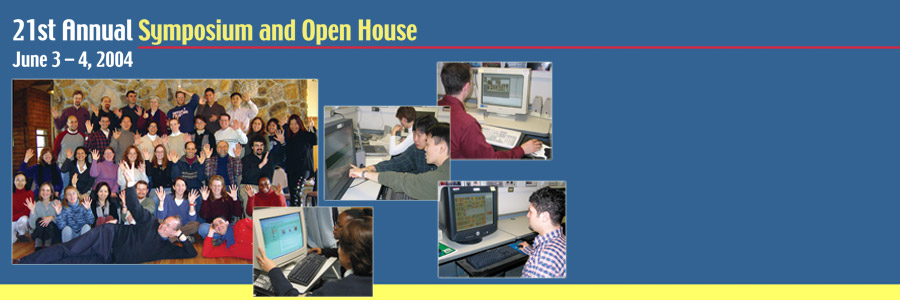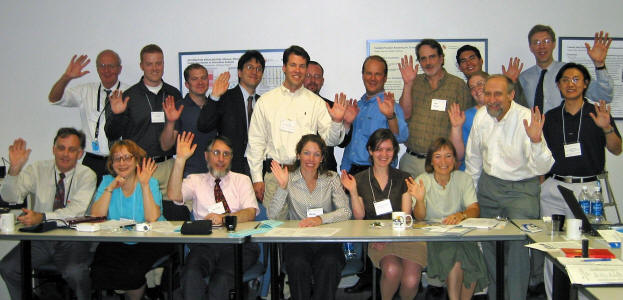
 |
|
Personal Medical Devices Workshop: Increasing Patient Healthcare Participation
Human-Computer Interaction Lab,
June 3, 2004, 9:00AM-5:00PM
|
||||||||||||||
|
The proliferation of inexpensive mobile
devices, in-home medical appliances, and personal health record keeping is
rapidly increasing the role of people in their healthcare and wellness
monitoring. This workshop will promote improvement to the usability aspects of
existing interfaces, help identify best practices, and promote consistency
across devices. The goals are to encourage awareness of lifestyle changes,
improve treatment compliance, facilitate data transfer to healthcare team
members, and demonstrate appropriate information visualizations. Researchers and
developers are invited to present their work. | ||||||||||||||
Sponsor | ||||||||||||||
Initial Schedule
|
| 8:30am | Light Breakfast and Introductions |
| 9:15am | Introduction: Interface Design
Requirements for Personal Medical Devices Ben Shneiderman (ben@cs.umd.edu), University of Maryland
Health & Wellness in the Digital Home |
| 10:30am | Break
Healthwear: Medical Technology Becomes Wearable (PDF) The Organization and Display of Blood Glucose Measurement Information
Asthma Management System:
Interface Design for a Personal Medical Device |
| 12:00 Noon | Lunch and walk |
| 1:15pm |
Mayo Clinic/IBM Computational Biology
Collaboration: UI Challenges Bill Hughes, IDX Corp Download Presentation Reporting on Successful Telehealth project with 3200 Veterans
Telemedicine: Expanding the Opportunity for Personal Medical Devices Designs for Dialogue Systems for Telehealth
Monitoring
PubMed on Tap: Access PubMed on Handheld, Wireless Devices |
| 4:15pm | Discussion of future directions Ben Shneiderman Panelists / Discussants
Peter B. Carstensen,
U.S. Food and Drug Administration.
|
| 4:45pm | Closing |
University of Maryland Class Projects
Medical Device Resources
iHealth:
Taking Control of Personal Healthcare
 |
| Back row: Peter Castensen, Chris Gough, Richard Mead, Matthew Kim, Corey Angst, Geoffrey Clapp, Bill Hughes, Ron Kay, Chase Ighani, Stephanie Fishel, Piet de Groen Front row: Adam Darkins, Dena Puskin, Michael Ackerman, Wendy Angst, Dina Demner, Mara Hemminger, Ben Shneiderman, Chunyuan Liao Not Shown: Sandy Pentland, Catherine Plaisant |
Introduction: Interface Design
Requirements for Personal Medical Devices
Ben Shneiderman (ben@cs.umd.edu),
University of
Maryland
The strong interest in medical informatics is shifting its
focus from physician-centered to patient-centered approaches. The emergence of
inexpensive, yet powerful computing technologies, accompanied by growing user
techno-fluency has led to a wide array of desktop, mobile, and web-based
applications. The increasing user participation in healthcare and wellness
monitoring has led to some turbulence because of increased patient knowledge,
assertiveness, and responsibility. Unfortunately, the numerous early systems
have inconsistent interfaces, incompatible file formats, and are often poorly
designed. We hope to identify opportunities for human-computer interaction
research and intervention to improve the potential for user success. I will show
prototype designs (in part from student projects:
http://www.cs.umd.edu/class/spring2004/cmsc434/index.html)
and suggest where improvements to commercial products could be made.
Healthwear: Medical Technology Becomes Wearable (PDF)
Alex Pentland, MIT Media Lab
Until recently, researchers have had little success in extending healthcare into the home environment, yet there clearly is a huge demand for this service. Americans currently spend $27 billion on healthcare outside the formal medical establishment, which they find difficult, expensive, and painful to access. A dramatic shift in the composition of the US population makes it absolutely necessary to develop such distributed systems.
To address these demands, a research group at the MIT Media Lab has been developing healthwear, wearable systems with sensors that can continuously monitor the user's vital signs, motor activity, social interactions, sleep patterns, and other health indicators. The system's software can use the data from these sensors to build a personalized profile of the user's physical performance and nervous system activation throughout the entire day-providing a truly personal medical record that could revolutionize healthcare.
The Impact and Opportunity of Ubiquitous and Secure Portable Personal Health Records
Wendy Angst, CapMed-Personal
HealthKey
The Electronic Health Record and Personal Health Record are
fast emerging markets. However, with the fragmented health care system and
mobile patients, many challenges still remain with the interoperability of these
systems. CapMed believes the patient is an untapped resource for aiding in the
interoperability of the patient's health information across multiple domains.
This discussion will provide an overview on the issues surrounding
interoperability, and provide a review of patient-held solutions available to
immediately address this problem. Emphasis will be placed on USB-Flash Disk
Technology and CapMed's participation in the Continuity of Care Record (CCR)
demonstration project at the Towards Electronic Patient Records conference in
Fort Lauderdale May 17-22.
Learning objectives of the presentation are as follows:
- Review of interoperability challenges
- CCR Demonstration Project review
- Evaluation results
Mayo Clinic/IBM Computational Biology Collaboration: UI
Challenges
Piet C. de Groen, Mayo Clinic/IBM Computational Biology Collaboration
The computer was introduced in healthcare facilities to store
and process demographic and financial data. At present, the content of the
medical record is being transferred from paper to electronic media, with some
facilities being paperless and others still partially paper-based. At the Mayo
Clinic we have nearly completed the transfer from paper to electronic media. As
the initial focus was patient care, the electronic format of the medical record
was created and optimized to allow access to the record of one patient at a
time. However, there is an increasing need to have access to cumulative data for
research, administrative, quality assurance and educational purposes.
At Mayo Clinic Rochester, in collaboration with IBM, we have created a data
warehouse that allows us to store clinical as well as genomic data of millions
of patients. In addition, we have created a search engine that can identify
subsets of patients with specific features [1]. This search engine is able to
handle a large variety of data types, including ICD-9 codes, DRG codes, various
forms of laboratory data (numeric data, text data, dilution data, changes from
baseline data), demographic data and free text data content (unmodified text,
lexicon-based normalized text, ontology-mapped concepts). In addition, the
search engine provides the opportunity to search using event profiles – a tool
that allows the query of specific conditions within a condition (“conditional
conditions”, for example colon cancers that were diagnosed at a specific year).
The resulting User Interface is complex. Extensive usability studies of
untrained users of components as well as the complete interface were done to
evaluate whether such a complex User Interface could be introduced as a general
warehouse search engine. The results will be discussed.
1. de Groen PC, Dettinger Richard, Johnson Pete. Mayo Clinic/IBM computational
biology collaboration: A simple user interface for complex queries. In:
Universal Access in HCI – Volume 4 of the Proceedings of Human - Computer
Interaction (HCI) International, 2003, pages 1083-7.
Integration of Consumer Collected Information and
Healthcare Provider Organizational Data to Facilitate Patient Outcomes
Bill Hughes, IDX Corp
The US healthcare delivery system is going through a major transformation from a
‘disease-centered model’ to a ‘patient-centered model’. One of the challenges
for the Healthcare Information Technology (HIT) industry is to develop the
technology infrastructure and tools to support the collaborative IT requirements
of the provider and an increasingly IT empowered consumer. As consumers assume
more responsibility for their health management they will demand better digital
access to their existing clinical information and the ability to share their
personal, via next-generation medical devices, biometric data with their
provider(s). Providers, on the other hand, will need to make the transition from
processing episodic snapshots of patient data to managing and processing a
continuous stream of patient data.
Supporting a Collaborative Care model will introduce a new set of usability
issues for both consumers and providers because information will be shared
seamlessly between the patient and provider. This will be especially important
in supporting chronic care management, e.g., diabetes. high-blood pressure, etc.
In this session IDX will share early prototypes that address the following
problems:
• The consumer’s ability to access their clinical record from the provider via
the Internet
• The ability for a diabetic patient to store their blood sugar data in their
personal health record and share this data with their provider
• The introduction of a provider based Case Manager application that would be
responsible for monitoring and managing a population of patients that are
remotely submitting blood sugar levels.
• A provider’s ability to view and process both patient and organization
captured biometric data.
• The ability for ongoing electronic collaboration between the provider and
patient via electronic messaging.
• The ability for the ‘Clinical System’ to automatically escalate abnormal
biometric data and generate alerts.
Telemedicine: Expanding the Opportunity for Personal
Medical Devices
Dena Puskin, Director of the Office for the Advancement of Telehealth,
HRSA
Dr. Puskin will review the lessons learned from the Office for the Advancement's 16 years of funding telemedicine activities, emphasizing the growing use of low cost technologies to reach patients in their homes. The Health Resources and Services Administration of the U.S. Department of Health and Human Services has established the Office for the Advancement of Telehealth (OAT) (http://telehealth.hrsa.gov/) to serve as a leader in telehealth. It is a focal point for HRSA's telehealth activities and as a catalyst for the wider adoption of advanced technologies in the provision of health care services and education.
Designs for Dialogue Systems for Telehealth Monitoring
Geoffrey Clapp, Health Hero Network, Inc.
The
challenge of any technology deployed in the home for remote patient monitoring
is building an engaging trusted interface between the technologies in the home
and the patient. Mr. Clapp will discuss the key lessons learned by Health Hero
Network over the last six (6) years of deploying the Health Buddy system into
patient homes, and the successful collection of millions of data points from
patients with varied clinical diagnosis, from common chronic illness such as
diabetes and chronic heart failure, to schizophrenia, hepatitis C, and pediatric
asthma.
Specifically, Mr. Clapp will address:
* building the patient trust with a device in the home
* eliciting factual, timely and appropriate information
* building a multi-disease interface
* cultural lessons learned from international deployment
* key limitations addressed over the deployment timeline
* the future roadmap of dialog systems for remote patient monitoring
PubMed on Tap: Access PubMed on Handheld, Wireless Devices
Dina Demner-Fushman, University of
Maryland
Medline and other NLM databases contain a wealth of biomedical information that can successfully support the clinical decision process, as well as facilitate consumers' access to health information.
PubMed on Tap is a testbed system for delivery of this information when and where it is needed, which implies a mobile information delivery system, and small wireless devices such as handheld computers (PDAs) and tablet PCs.
In designing the interface for the small screens of these devices we strived to preserve the functionality available in PubMed, NLM's service that provides online access to over 14 million citations for biomedical articles. Here we present the latest version of the interface for the handheld computers, and the changes in its design based on a small usability study and users' feedback.
Last Modified June 07, 2004, jkustan@umd.edu